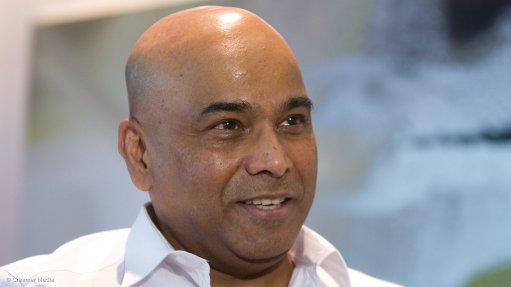
JOHANNESBURG (miningweekly.com) – The current crisis in the South African mining industry presents an opportunity for a sea change, says former Bateman CEO and former Public Enterprises director-general Dr Sivi Gounden.
The chairperson of HolGoun, an unlisted company with a wide range of mining sector investments, says South Africa is using relatively unsophisticated labour to mine complex orebodies and expecting the equation to balance.
“We’re not going to be able to apply the same methodology and hope for a different outcome,” Gounden comments in a Mining Weekly Online video interview (see attached).
In reality, the only way to reduce the unit output cost is to marry innovative technology to an upskilled labour pool.
“We’ve fallen behind in research and development,” says the head of the company that is also the second-biggest shareholder of Samancor Chrome and the developer of a complex uranium and power project in the Springbok Flats area.
South African mining needs to pursue a technology trajectory to put it back in line with other mining countries also exploiting complex orebodies at depth.
The right technologies need to be identified and the labour pool needs to be upskilled in order to lower the unit cost of production.
Instead, mines are being closed and put on care and maintenance with huge loss and suffering in a sector that is being hit by the perfect storm of global recession and down cycle.
“I do think this presents an opportunity to effect a sea change on how we go about mining in South Africa,” says Gounden, who in the last ten years has served as a nonexecutive director on the boards of companies such as Optimum Coal, Lonmin plc, Grindrod Limited and Anglo American South Africa.
A doctor of engineering from the University of Natal, Gounden says that great strides have been made in deep mining and considerable work has also already been done on low-profile continuous mining machinery that virtually tracks uneven narrow-seam geology.
“We’re also seeing some totally left field, out-of-the-box plays,” says the former Cosatu adviser of AngloGold Ashanti’s new blast-free narrow-reef technology that safely mines “all the gold, only the gold, all the time”, as well as the robotics offering of the Council for Scientific and Industrial Research.
The AngloGold Ashanti technology, in his view, presents “an incredible opportunity” and there are also several other parties with promising offerings.
The many mining methodologies available need to be taken to the next level, taking advantage of technologies, including robotics, which have come such a long way in the last two decades.
Lessons can be taken from Canada and Australia, where there are ongoing mining technology accomplishments.
HolGoun holds prospecting rights to 91 000 ha in the Springbok Flats, in the Settlers region of the Limpopo province, through its subsidiaries, HolGoun Uranium & Power, HolGoun Energy and Canyon Springs.
The resource area contains uranium, coal and coking coal.
HolGoun Uranium & Power is focusing on the development of a uranium mine with a production capacity of two-million pounds of uranium oxide a year and power generation capacity of 660 MW as a co-product from the process.
HolGoun Energy will be developed to produce coking coal for the metallurgical industry and thermal coal for power stations, and Canyon Springs is earmarked as an openpit mine with the production of thermal coal for local power stations and coal for the export market.